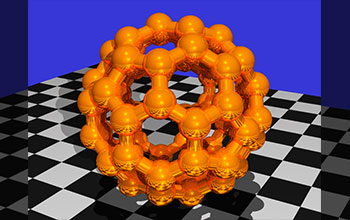Multimedia Gallery
Bond-and-stick model of C-60 Buckminsterfullerene molecule
A ray-traced picture of a bond-and-stick model of a C-60 Buckminsterfullerene molecule, a naturally occurring form of carbon with 60 carbon atoms per molecule, arranged in the structure of a soccer ball. It is named after the architect R. Buckminster Fuller, who designed geodesic spheres, which happen to have the exact structure of C-60 molecules.
More about this image:
The model in this image is not based on the actual chemical structure of C-60 but on atom positions generated in the spirit of R. Buckminster Fuller by subdividing a regular dodecahedron. The model was generated by placing spheres at atom positions and cylinders along atom-atom bonds. The image was generated by ray-tracing the model with a reflective surface floating on top of a checkerboard. The ray-tracing algorithm used point light sources and adaptive anti-aliasing. (Year of image: 2000)
Credit: Image generated by Oliver Kreylos, Center for Image Processing and Integrated Computing (CIPIC), University of California, Davis. This image does not show an actual C-60 Buckminsterfullerene molecule.
Images and other media in the National Science Foundation Multimedia Gallery are available for use in print and electronic material by NSF employees, members of the media, university staff, teachers and the general public. All media in the gallery are intended for personal, educational and nonprofit/non-commercial use only.
Images credited to the National Science Foundation, a federal agency, are in the public domain. The images were created by employees of the United States Government as part of their official duties or prepared by contractors as "works for hire" for NSF. You may freely use NSF-credited images and, at your discretion, credit NSF with a "Courtesy: National Science Foundation" notation.
Additional information about general usage can be found in Conditions.
Also Available:
Download the high-resolution TIF version of the image. (494.8 KB)
Use your mouse to right-click (Mac users may need to Ctrl-click) the link above and choose the option that will save the file or target to your computer.



